GROUNDHOG DAY - ETHICS IN WILDLIFE PHOTOGRAPHY PART @$%^#*
In the past few days I've seen links and comments about the article in the May 2015 edition of Audubon Magazine called "Too Close for Comfort", about the ethics of wildlife photographers. The article details several examples of photographers disturbing nesting birds in Florida and the conflicts that are arising from their behavior. This is a tired old subject that I have dealt with for years and written about a few times in the past, (here is a link to a blog I wrote two years ago, on the occasion of another blow up: http://bobmacdonnell.zenfolio.com/blog/2013/3/about-photography), but I'll add my two cents again, against my better judgement.
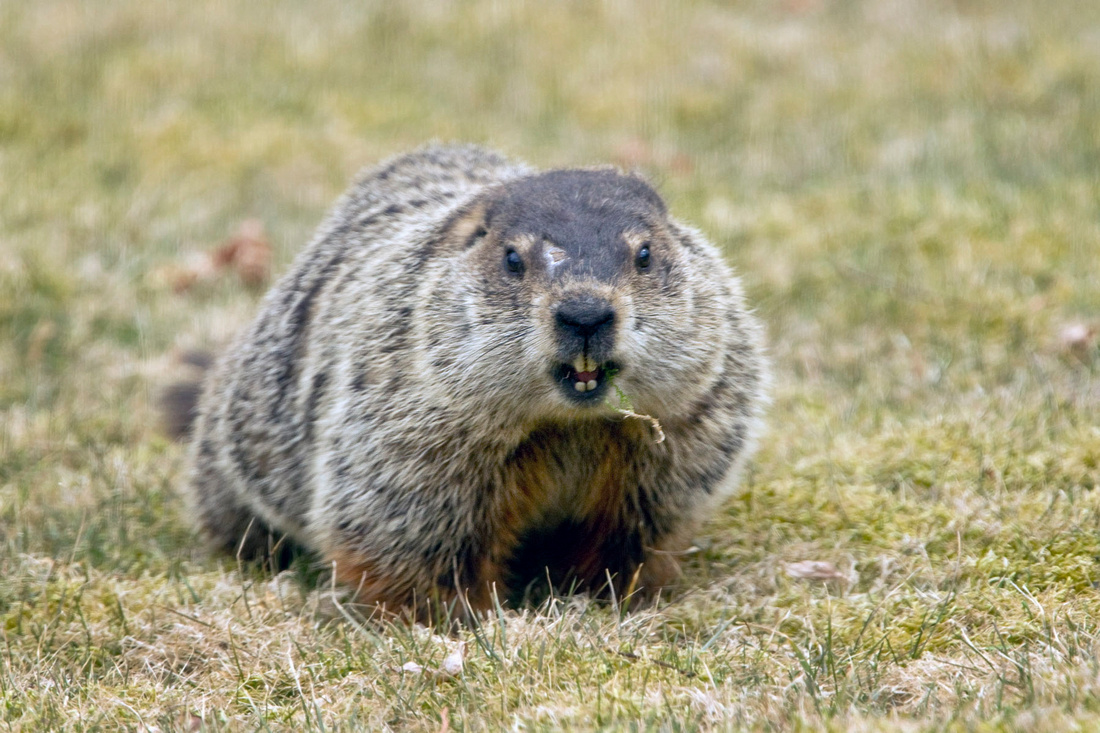
 The Audubon article begins with a Florida photographer who was prosecuted for violating the Endangered Species Act by getting too close to a Snail Kite nest on several occasions, ignoring a sign posted to keep viewers a certain distance away. The photographer in question was leading a commercial tour for other photographers, taking them by boat to what I assume is a pretty remote location. While I don't know him personally, I am familiar with his work and he is very good at what he does, and has built his tour business on those talents. Of course that doesn't give him the right to violate the law, and it appears that his case is pretty black and white. The more common problems are the gray areas where nobody sees eye to eye.
The Audubon article begins with a Florida photographer who was prosecuted for violating the Endangered Species Act by getting too close to a Snail Kite nest on several occasions, ignoring a sign posted to keep viewers a certain distance away. The photographer in question was leading a commercial tour for other photographers, taking them by boat to what I assume is a pretty remote location. While I don't know him personally, I am familiar with his work and he is very good at what he does, and has built his tour business on those talents. Of course that doesn't give him the right to violate the law, and it appears that his case is pretty black and white. The more common problems are the gray areas where nobody sees eye to eye.
Experienced wildlife photographers know that having a good knowledge of their subjects is one of the most important tools they can possess to get good pictures. Many started out as biologists or naturalists, and some may know as much about the creatures they photograph as anyone, including birders or researchers. While hard-earned experience and knowledge is helpful, it can sometimes lead to hubris, and allow a photographer to feel it's okay to push a subject to get the desired picture. With some newer photographers, a lack of experience may cause them to cross the line without even knowing it, and with some there is just a lack of concern for their subjects. The question is what are the limits and who determines them.
Working as a newspaper photographer, I was occasionally able to gain access to protected wildlife through my job and was able to get pictures that might not be accessible to everybody. I have tried to work with scientists and researchers both for access and for guidance on how to safely photograph certain subjects, but is it okay for a newspaper photographer or one shooting for National Geographic or Audubon to take certain pictures and not okay for another photographer?
As a photojournalist, most of my work was to illustrate news stories with informative and interesting pictures. My approach to wildlife photography is similar, and I try to portray creatures in a way that tells something about their lives, what they eat, where they live ....etc. It's for that reason that I like photographing nesting birds, because it is such an important part of their lives. I know it's a sensitive subject, and there are many wildlife photographers will never photograph birds on the nest and bristle when others do. I wrote a blog post about photographing nesting birds a long time ago, which remains an unpublished draft because other than me, who cares what I think?. I'm not trying to encourage anyone else to photograph nesting birds, just explain how and why I do.
One of my earliest nest encounters was in the 1990's with a Yellow Warbler which I found just off a path in a popular park. I watched the nest from a distance for a couple weeks (I knew not to photograph until the chicks hatched because there would be a greater chance that they could abandon the site). I told a few other local birders who were very helpful and friendly to me about the nest and when the chicks hatched, I waited through the weekend when the park was busy and went early Monday morning to get my first pictures. When I arrived at the nest, there was a photo blind set up in front of it, so I walked around the rest of the park for a while and returned again but the blind was still there. I set my gear down about 50 yards away and waited until the photographer eventually got out and started to yell at me. He gave me some B.S. story about how he had been photographing the nest for weeks and had sold several pictures from it already, but I found out he was on a bird walk that weekend led by one of the birders I'd told about the nest. I came back later and found that he'd cut some branches below the nest exposing the bright nest fibers and making the nest much more conspicuous. The birds were okay, but I learned an important lesson that has stuck with me since. Never tell anyone else about a found nest.
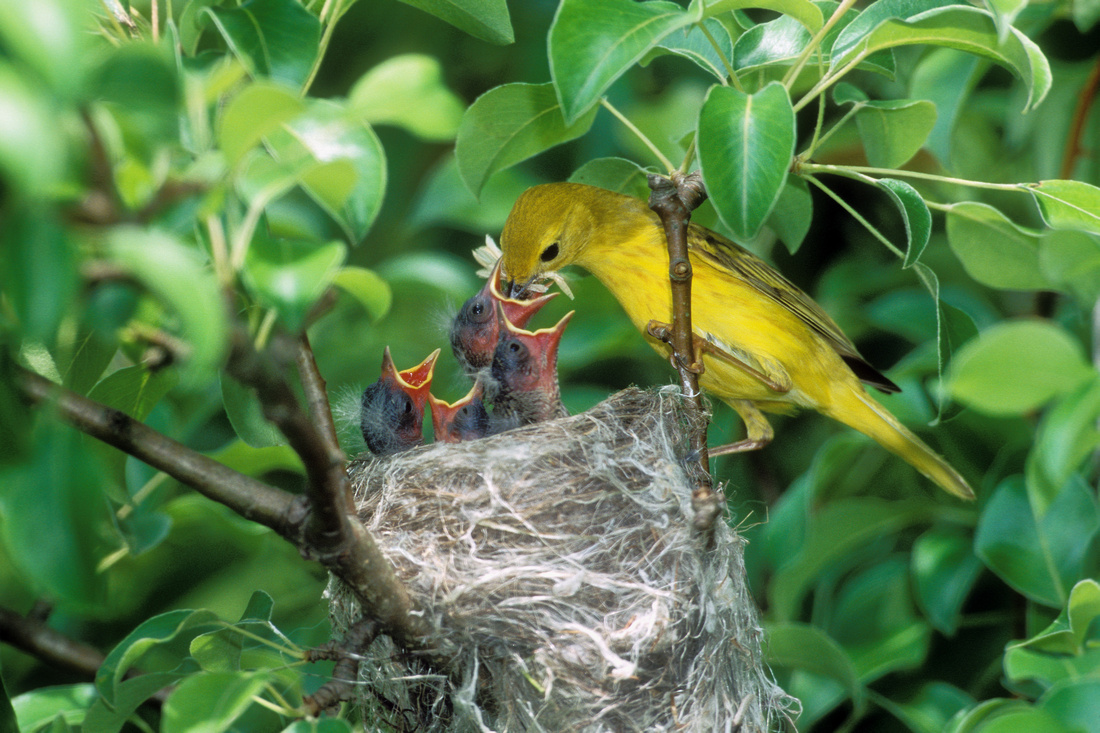

The Audubon article talks about the danger of photographers leading groups of people to nesting areas. A year after my Yellow Warbler episode, I went on a group tour to Churchill led by professional wildlife photographers. There were six clients and two guides and we photographed nesting birds, mostly shorebirds, on the open tundra. It was a productive trip, but there were a few things I was uncomfortable with. I felt uneasy being in a group of large men shooting small birds from a few yards away, even though the bird seemed to tolerate our presence.

 On top of that, there were some in the group who wanted to get closer than others were comfortable with, causing the birds obvious stress. I was excited to photograph these beautiful birds in breeding plumage, sitting on their nest, but felt bad when they went through their distraction displays when we first approached or when someone moved too close.
On top of that, there were some in the group who wanted to get closer than others were comfortable with, causing the birds obvious stress. I was excited to photograph these beautiful birds in breeding plumage, sitting on their nest, but felt bad when they went through their distraction displays when we first approached or when someone moved too close.
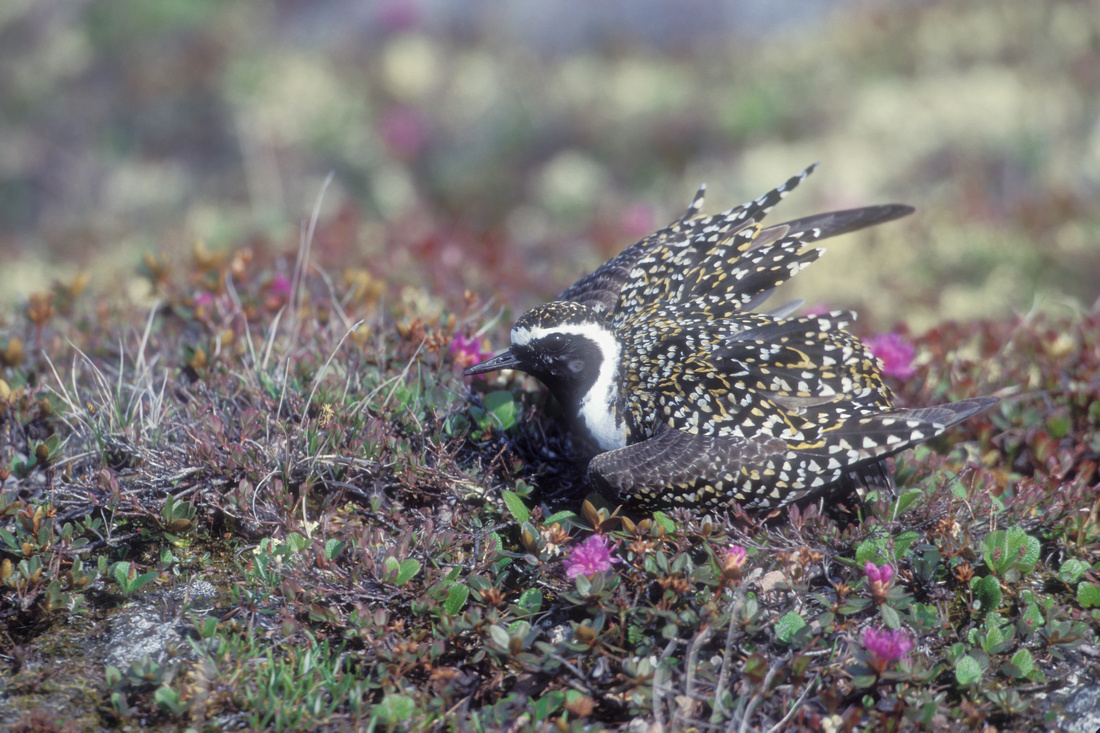
 One day we found a beautiful Pacific Loon, one of my main target species for the trip, on its nest and were getting incredible full frame pictures in great light.
One day we found a beautiful Pacific Loon, one of my main target species for the trip, on its nest and were getting incredible full frame pictures in great light.
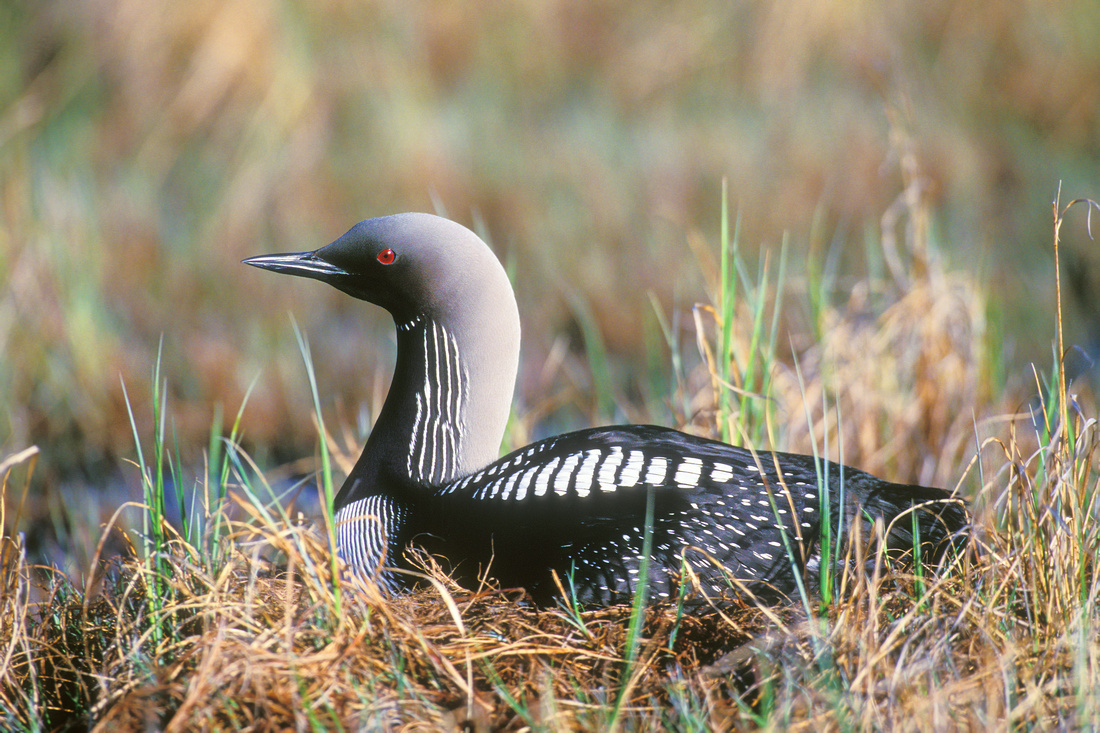
 Some in our group kept creeping closer, until the bird finally sprang from the nest with a loud sound I can't begin to describe and started flailing and splashing in the pond nearby. All our cameras were clicking away for the short while this occurred, and the pictures are pretty wild, but I had a sinking feeling after it happened. I learned later that this was an alarm display and have seen published pictures of other loons just like it. The captions usually describe a rival loon approaching or a predator flying overhead, but now that I know what it is I hope I don't see it again.
Some in our group kept creeping closer, until the bird finally sprang from the nest with a loud sound I can't begin to describe and started flailing and splashing in the pond nearby. All our cameras were clicking away for the short while this occurred, and the pictures are pretty wild, but I had a sinking feeling after it happened. I learned later that this was an alarm display and have seen published pictures of other loons just like it. The captions usually describe a rival loon approaching or a predator flying overhead, but now that I know what it is I hope I don't see it again.

 The biggest problem I had with the group dynamic turned out to be that I got basically the same shots as the rest of the group and that felt less satisfying to me. My goal at the time was to sell pictures for publication, but I don't think I ever sold any from the trip. The guides that led the tour and one or two of the clients had pictures from the trip published in books and articles about the location, but the market for those type of pictures was pretty much covered. Photographing with a group and getting the same or similar pictures as a bunch of other photographers was not only less satisfying, but it was also bad business. That was the first, last and only group photo tour I've been on.
The biggest problem I had with the group dynamic turned out to be that I got basically the same shots as the rest of the group and that felt less satisfying to me. My goal at the time was to sell pictures for publication, but I don't think I ever sold any from the trip. The guides that led the tour and one or two of the clients had pictures from the trip published in books and articles about the location, but the market for those type of pictures was pretty much covered. Photographing with a group and getting the same or similar pictures as a bunch of other photographers was not only less satisfying, but it was also bad business. That was the first, last and only group photo tour I've been on.
Earlier that year, my wife and I drove to Florida to visit her family and I talked her into stopping at the Venice Rookery so I could take some pictures. We arrived in the early morning darkness, and when the sun finally rose, I was underwhelmed by the tiny stand of mangroves in the small pond at the Venice municipal complex. Among the dozens of photographers there, I met two whose work I'd seen published and complimented them on it. The asked me where I was from and I told them I was visiting from Connecticut and was hoping to visit a few of the Florida birding hotspots and asked if they had any suggestions. What happened next shocked me, but they both got angry and said they were tired of outsiders coming in and photographing in their home territory and cutting into their stock business. Florida .... Vacationland ....? Turf is turf, and it was being defended.

 The situation today is almost the exact opposite. With the advent of digital photography it seems like everyone has a camera and the flood of new photographers has completely changed the landscape of all types of professional photography, wildlife photography included. Photographers who once made a living selling stock pictures to magazines and calendars found the overwhelming volume of new work and the diminishing number of outlets for it caused publication fees to plummet, crashing their business. Magazines like Audubon were always tough to break into, but even the smallest magazines now act like you are bothering them by trying to submit pictures you want to be paid for, and they pay accordingly . Photographers who once guarded their prime shooting spots figured out that they could make up for lost publishing income by leading tours for the hordes of newcomers to those same locations. Common sense dictates that probably doesn't benefit the creatures there.
The situation today is almost the exact opposite. With the advent of digital photography it seems like everyone has a camera and the flood of new photographers has completely changed the landscape of all types of professional photography, wildlife photography included. Photographers who once made a living selling stock pictures to magazines and calendars found the overwhelming volume of new work and the diminishing number of outlets for it caused publication fees to plummet, crashing their business. Magazines like Audubon were always tough to break into, but even the smallest magazines now act like you are bothering them by trying to submit pictures you want to be paid for, and they pay accordingly . Photographers who once guarded their prime shooting spots figured out that they could make up for lost publishing income by leading tours for the hordes of newcomers to those same locations. Common sense dictates that probably doesn't benefit the creatures there.
With so many more people photographing wildlife today, it's also harder to stand out or get noticed unless you have some really unique pictures and may be willing to push the limits with your subjects. In a way, magazines, including Audubon, may be indirectly contributing to the problems when their editors select the most unique and unusual pictures to publish. If that's what it takes to get noticed or published, there are always people who will do it, and others will follow their lead. Shooting wildlife up close or with a wide angle lens, or using remote cameras or camera traps are all growing trends in wildlife photography. On the same web page for the Audubon story documenting these ethical issues with wildlife photographers is a link to the 2015 Audubon Photo Contest winners. In the gallery of top 100 photos are examples of the same things they are decrying, including extreme close-ups, wide angle close-ups and pictures of birds at their nest. One of the contest judges is a photographer whose work I admire, but I've seen close-up wide angle pictures of nesting birds on the tundra that he's taken published in National Geographic.
I don't know exactly how any of those photographs were made, but surely some birders or naturalists would take issue with these photographers if they were there to witness it. I do know that if editors and judges use or select those kinds of pictures, more photographers will copy them. While working on a photo package about the Audubon Christmas Bird Count for the Hartford Courant, I showed some of my stock photos to my editor, and she selected a picture of a screech owl with its eyes wide open. I tied to talk her into picking a picture where the owl didn't look so alarmed and wasn't staring right at the camera, but she liked owl with its wide open, as most editors do. Is it any wonder then that photographers will whistle, squeak, squeal or do whatever they can to get an owl to open its eyes, regardless of how it affects the owl.
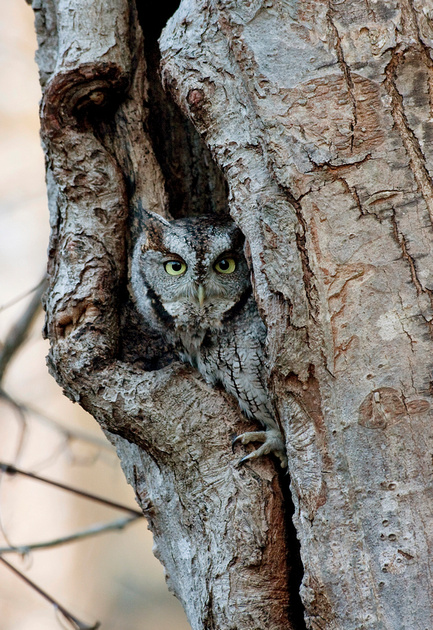



I've been trying more wide angle and remote camera techniques in recent years to get a different look than the long lens, shallow depth of field perspective so typical of most wildlife photography, including my own. Just as the wide angle shot from the Osprey nest I wrote about in my earlier blog post angered some, I'm sure there are many who would not approve of these recent efforts, not knowing how they were obtained. The Wood Thrush nest photo below was taken with a remote camera on a pole that reached nearly 10 feet over my head. I watched the bird from my car, from about about 40 yards away, for more than an hour before it left the nest, then jumped out with my contraption already set up and took about 20 pictures. The whole thing lasted around a minute and I returned to my car and the bird returned to the nest. I like the picture and I know it did not result in any harm to the birds, I saw the chicks fledged from the nest, but I'm sure this falls in the gray area for some and is completely out of bounds for others.
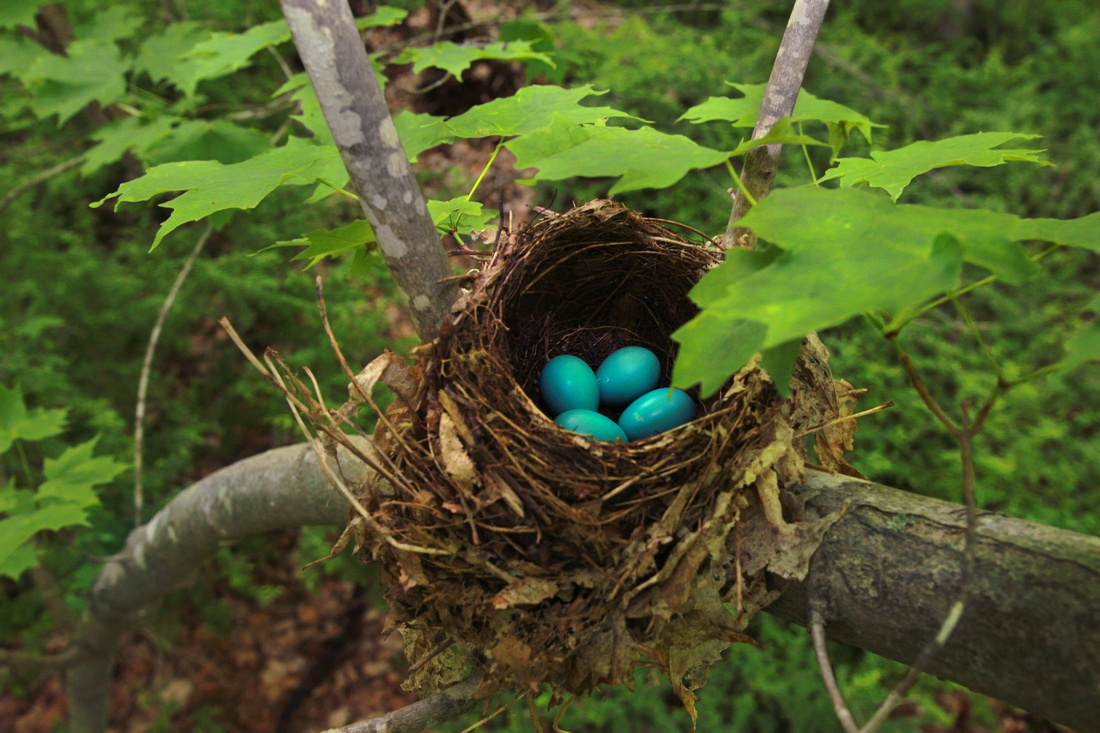

I took a philosophy course in college called Ethics. I was a biology major at the time and can't remember much of what the class was about, but I do remember that there didn't seem to be right or wrong answers, you had to subjectively reason your response. This wasn't easy to grasp for a science major. One of my favorite wildlife photography books is called "Vanishing Songbirds" by Eliot Porter. It contains dozens of beautifully lit, sharply detailed large format photos of many North American songbirds at their nest that were taken 40 or 50 years ago. The book was made in an effort to document the decline of the birds Porter was so passionate about and receives high praise, even today. I love the pictures and would like to emulate them, but by today's photography ethics, these pictures would be considered criminal evidence.
I spend lots of time in the woods each spring looking for nests and find a fair number. I never even try to photograph most of them because they are hard too even see. I have found Blue-winged Warbler and Common Yellowthroat nest sites, down to a square foot, but never seen an actual nest because I'd never part the dense clumps of vegetation they are buried in. Instead, I do the best I can to capture those kind of photos within my ethical standards. My chances are greatly limited, and the pictures are usually flawed by some distracting element I wont remove. The one picture I've taken that comes closest to those Elliot Porter pictures is one of a Worm-eating Warbler nest. I was parked in a pull-off area on a dirt road in the forest listening for songbirds with the windows down and saw the birds bringing nest material to the leaf covered hillside adjacent to my car. I was able to watch the progress of the nest for the next few weeks from my car, and eventually photograph it from an open window covered with mosquito netting. It's one of my favorite photographs because I was able to see right into the nest and into their world like I was a fly on the wall, the birds seemingly unaware of my presence, which made it so satisfying.

 In the nearly 30 years I've worked as a photographer, it has changed more dramatically than I could have imagined. New technology has made wildlife photography more accessible to many more people and the internet has made it much easier to learn how and where to find subjects. Photographers' work will evolve over time and some will shape and others follow the new styles and trends. Like most things these days, the trend is more extreme. The one thing that has not changed in that time is that wildlife photographers have come under fire for "endangering" their subjects. Game farms, baiting, getting too close, flash photography, group tours, owl roosts, Snowy Owls, Bald Eagle nests .... the list goes on and on. It's easy for someone with no interest in wildlife photography to say here's the line and you're wrong if you cross it. It's not that simple. Wildlife would be better off if there weren't six billion people on earth, too, but I don't see those people volunteering to check out. Right or wrong, black or white, or the dreaded gray areas, pushing the limits has always been a part of progress. I think photographers need to figure out when we have reached the line, beyond which we are harming our subjects, and hopefully we don't cross it.
In the nearly 30 years I've worked as a photographer, it has changed more dramatically than I could have imagined. New technology has made wildlife photography more accessible to many more people and the internet has made it much easier to learn how and where to find subjects. Photographers' work will evolve over time and some will shape and others follow the new styles and trends. Like most things these days, the trend is more extreme. The one thing that has not changed in that time is that wildlife photographers have come under fire for "endangering" their subjects. Game farms, baiting, getting too close, flash photography, group tours, owl roosts, Snowy Owls, Bald Eagle nests .... the list goes on and on. It's easy for someone with no interest in wildlife photography to say here's the line and you're wrong if you cross it. It's not that simple. Wildlife would be better off if there weren't six billion people on earth, too, but I don't see those people volunteering to check out. Right or wrong, black or white, or the dreaded gray areas, pushing the limits has always been a part of progress. I think photographers need to figure out when we have reached the line, beyond which we are harming our subjects, and hopefully we don't cross it.